The post ESO Patient Registry Customer Webinars appeared first on ESO.
]]>
ESO Patient Registry Onboarding Reimagined: A Faster, Smarter Start
Audience: Customers who have not started or have just started the onboarding process will benefit most from this webinar, but all customers are welcome
We’ve upgraded our onboarding for ESO Patient Registry – and we’re ready to show you how. Join the ESO Customer Onboarding Team for a tour of the new ESO Patient Registry onboarding journey. We’ll review how we evaluated customer feedback and applied enhancements, and what to expect when starting the onboarding process.
When: Wednesday, July 9, 2025 from 12-1 p.m. CT
Where: Virtual
What’s New In ESO Patient Registry
Audience: Any hospital leaders, trauma program leaders, and trauma registry professionals who use ESO Patient Registry or a legacy CDM, DI, or Lancet by ESO patient registry product
Join ESO Director of Product Management, Steve McComb, and Executive Director – Hospital, Karla Jones, MSN, RN, TCRN, for an in-depth look at the ESO Patient Registry product roadmap. During the webinar, you’ll learn about recently released features, what features are in development now, and what’s coming in both the short-term and long-term. You’ll also have an opportunity to get your questions about the product roadmap answered.
When: Wednesday, August 13, 2025 from 12-1 p.m. CT
Where: Virtual
Leveraging FHIR to Enhance Data Interoperability in ESO Patient Registry
Audience: Any hospital leaders, trauma program leaders, and trauma registry professionals who use ESO Patient Registry or a legacy CDM, DI, or Lancet by ESO patient registry product
Join our ESO subject matter experts for an in-depth look at how FHIR (Fast Healthcare Interoperability Resources) is revolutionizing trauma data management. Whether your organization is already enabled with FHIR in ESO Patient Registry or you haven’t started your upgrade, you’ll benefit from learning more about the current state and where we’re heading next.
When: Wednesday, September 10, 2025 from 12-1 p.m. CT
Where: Virtual
The post ESO Patient Registry Customer Webinars appeared first on ESO.
]]>The post Wave 2025 Recap: Top 5 Topics in Hospital and Trauma Care appeared first on ESO.
]]>1. Good data is the foundation
Providing consistent, high-quality care isn’t a one-person job; it’s a system-wide effort. At Wave 2025, speakers emphasized the value of collecting accurate data, sharing benchmarks, building feedback loops, and supporting providers with the information and education they need to act.
It’s been said that there are three kinds of falsehoods: a fib, a downright lie, and statistics. Dr. Remle Crowe and Ali Treichel from ESO want to ensure no one falls prey to the third one in session, Dogs and Data: A Cautionary Tail. They shared how to gauge the quality of study results, what statistical jargon means, and the importance of staying curious about results.
For fans of the show “Ted Lasso,” TowerDIRECT’s Jason Drinkwater, Paramedic V – Quality Coordinator, led a familiar-sounding session: Be Curious, Not Furious: A Data-Driven Approach to Change. Before jumping to fix a perceived problem, it’s imperative to ask questions of the right people. Always include frontline workers for valuable insight and buy-in. Otherwise, you know what happens when you assume.
2. Stay in step with change
Trauma care is a lifelong profession for many. Presenters shared experiences, best practices, and evidence-based research to spotlight ways to stay in step with trends and technology.
First responders – and indeed, all healthcare providers – must demonstrate their value to taxpayers, patients, employers, payers, city council, and more. In From Data to Impact: Proving the Value of the Services You Deliver, Matt Zavadsky, EMS/Mobile Healthcare Consultant at PWW Advisory Group, shared which types of data resonate with stakeholders and how to tailor information to satisfy each. The practical takeaway: “Value is based on who is writing the check.”
Leveraging the ESO Patient Registry During an American College of Surgeons Site Survey, presented by Matthew Derkrikorian, Trauma Program Manager at Rady Children’s Hospital, offered a look at how Rady Children’s Hospital prepared for and completed the first ACS Site Survey using ESO’s updated registry.
Next, for trauma centers wondering how their performance compares nationally, ESO’s Dr. Tony Fernandez shared findings from the 2024 ESO Trauma Index in Benchmarking Care for Quality Improvement. Download the report for new insights and best practices. It’s a valuable tool to spark quality improvement conversations.
In Sepsis Treatment: Good for the Patient and the Payor, Erik Axene, CEO and Founder of Axene Continuing Education, updated attendees on trends and evidence, including artificial intelligence (AI) and machine learning solutions, trying to get ahead of this deadly issue.
Building Resilience: The Power of Standardization in Navigating Change showed how CommonSpirit Mountain Region approached a trauma registry upgrade by centralizing and standardizing operations. Melissa Sorensen, RN Trauma Registry Manager, shared how the process built collaboration and positioned the team to adapt effectively.
3. Culture that supports improvement
Many sessions acknowledged a hard truth: data alone isn’t enough. Change happens when organizations build a culture that embraces reflection, transparency, and learning.
Brooke Burton, Quality Improvement Manager at Unified Fire Authority, led Mistake or Murder: What Can EMS and Hospitals Learn from the Vanderbilt Case? The in-depth examination showed how hospital culture contributes to patient and worker trust.
Scott Bourn from ESO led a practical session, Strategies for Influencing Change Using Data, reminding us that how you use data and information matters. If statistics were enough, no one would smoke! Knowing how to influence without judgment is crucial for improving internal hospital culture and providing supportive patient care.
A Call to Action: Amplifying the Roles of the Level III and Level IV Trauma Centers, led by Kelli Vaughn, Trauma Program Manager at John D. Archbold Memorial Hospital, detailed how Georgia’s smaller trauma centers, long excluded from larger system initiatives, created a standing committee to shape care across all levels of trauma care. .
Finally, Michael Kaduce, Director at The Falck Health Institute, addressed the challenge of how to start a quality improvement project. Once your hospital team has data in hand and leadership on board, pick something low-cost and high-impact. He provided ideas, examples, and tools in Bringing Research to Frontline Providers: Supporting Your Quality Management Program.
4. EMS-hospital collaboration improves outcomes
Multiple sessions focused on the continuum of care. Hospitals that make real-time data accessible to EMS agencies and close the loop on outcomes see stronger relationships, better documentation, and improved patient care.
In the session From the Roadside to the Bedside to the Hospital Boardroom, Jonathan Sague, Regional Chief Operating Officer, shared how University Hospitals (UH) are redefining EMS-hospital collaboration. By treating EMS as partners and sharing timely data and feedback, UH improved care transitions, documentation quality, and frontline morale. As a bonus, stronger EMS relationships can increase patient volume, which leads to financial gains and hospital growth.
Next, Justin Nelson, EMS Liason at VHC Health, shared their experiences with ESO Health Data Exchange (HDE) in The Bridge to Better Patient Outcomes. Instead of three separate interfaces plus encrypted email to communicate with EMS agencies, VCH only uses HDE. Stronger EMS relationships translated into a 7% increase in volume, and 91% of patient records match – up from 18%.
In A Healthcare Shift: How Virtual Nursing and Hospital at Home Programs Are Changing The Landscape of Patient Care, Lisa Meyer from ESO examined how virtual care is reshaping patient interaction models – and what that means for EMS and hospital alignment moving forward.
5. Challenge precedent
In a conference centered on using data, multiple sessions tackled common beliefs and techniques that no longer serve trauma care.
In the popular Hot Topics in Trauma Care, experts Dr. Glen Tinkoff, System Chief, Trauma and Acute Care Surgery at University Hospitals, Dr. Samir Fakhry, VP for Center for Trauma and Acute Care Surgery at HCA, and ESO’s Dr. Brent Myers examined evidence on trending issues in trauma care. High points included:
- Delaying surgery to ‘tune up’ patients doesn’t help, as COPD won’t be cured in three days.
- Blame pickleball for the increase in geriatric falls.
- There is enough data to support whole blood use in trauma. But haven’t solved delivery or replenishment.
- Not all traumas require a full trauma activation.
- Prepare for increased pediatric behavioral health and pediatric gun violence.
Next, in Ketamine Therapy for the Wounded Helper, Dr. Alexandra Jabr, Educator at Emergency Resilience, shared research and personal experiences with Ketamine as part of a holistic approach to PTSD. She presented evidence and distinguished medical versus recreational use, while addressing its limited FDA approval and credibility.
Taking aim at hospital-wide issues like overcrowding, burnout, and boarding in It’s Everyone’s Problem: The Ongoing Challenge of Patient Flow and Capacity Constraints, Lisa Meyer from ESO shared tactics hospitals are deploying to reduce adverse events and improve patient movement.
Configuring Your Trauma Registry for Successful Reporting and Performance Improvement featured Lee Ann Wurster, Trauma and Burn Program Manager at Nationwide Children’s Hospital, who detailed how intentional registry setup and onboarding helped maintain real-time abstraction and continuous reporting.
Stay ahead of what’s trending in the industry.
Our data experts at ESO compiled a few resources to help you keep up with a shifting industry while using aggregated data to ensure your organization stays at the top of its game. Check out the 2024 ESO Trauma Index to see where your organization stands against national benchmarks in important metrics.
It’s not too early to start thinking about Wave 2026!
Mark your calendars for April 7-10, 2026, to join us in Austin, TX, for four days of thought leadership, networking, and learning. If you’re interested in being the first to get the inside scoop on what data-driven advancements and technologies are trending industry-wide, mark your calendars and stay tuned to register.
The post Wave 2025 Recap: Top 5 Topics in Hospital and Trauma Care appeared first on ESO.
]]>The post Wave 2025 Recap: Top 5 Topics in EMS and Fire appeared first on ESO.
]]>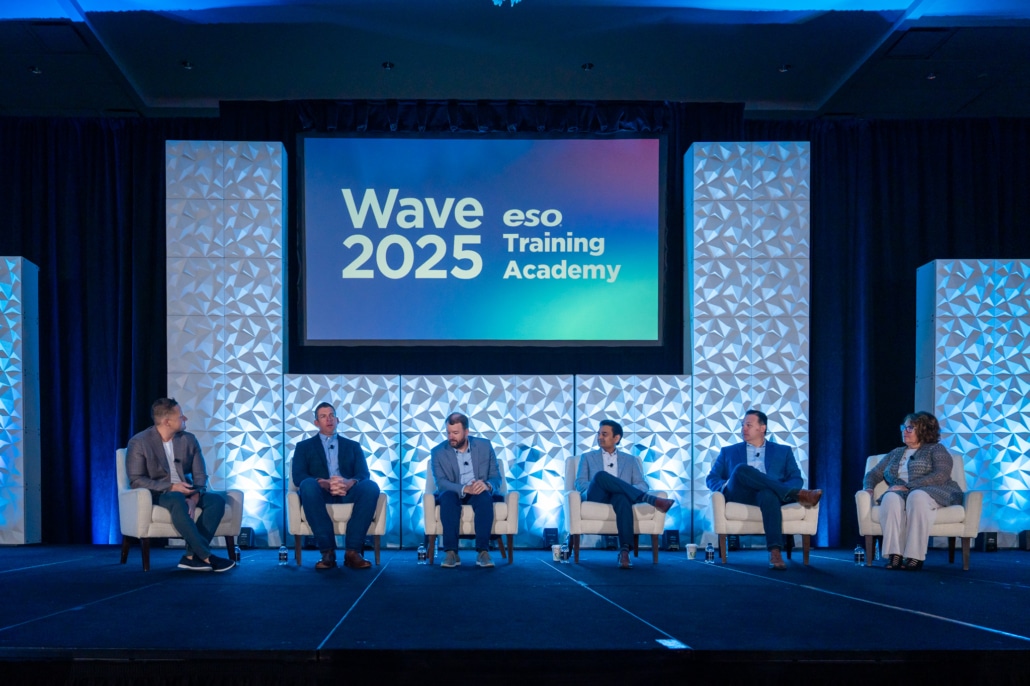
Held from April 22-25, Wave 2025 covered a variety of impressive topics throughout the week. Here are the five themes that were at the forefront of discussions in fire and EMS:
1. Artificial Intelligence
Front and center on the world stage, AI is an incredible new technology that we’re only skimming the surface of what it can bring to the industry. Despite the fact that we need to proceed cautiously and responsibly, we’re excited to see how its role will continue to evolve in the years to come.
At Wave, the air was abuzz with talks surrounding AI. Chief Innovation Officer of Cincinnati Children’s Hospital, Todd Ponsky, used his session Global Education Moonshot: Using AI and Media to Transform Medical Knowledge Access to shed light on the new technology’s role in fighting global disparities in patient care.
Cincinnati Fire Department’s program manager, Robert Hug then shared how his department is transforming their documentation and analyses of their data through the integration of AI into Snowflake in Beyond ChatGPT: Unlocking the Power of AI in Snowflake.
Finally, we learned how ESO will be tackling AI from ESO Senior VP of Engineering Russell Beggs, Senior VP of Product Reinhard Ekl, and Chief Innovation Officer Brandon Martinez in their session Artificial Intelligence in ESO Products: Efficiency Gains You Can Trust. They discussed the responsible approach ESO is using to harness the new technology to improve the efficiency and accuracy of documentation through our new auto-generated narrative feature.
2. Mobile Integrated Healthcare
EMS is on the front lines of providing medical care for their communities, treating the most vulnerable of society, oftentimes on a repeated basis. More than ever before, data and strategic partnerships are being used as tools for empowering first responders to get to the root of patients’ issues through Mobile Integrated Healthcare/Community Paramedicine programs. These programs can be incredibly impactful for both the agencies and the patients they treat.
Kicking off the discussion, Associate Chief Medical Officer of Global Medical Response, Gerad Troutman, explored the power of these alternate care models in redirecting non-life-threatening cases away from the ER while providing proactive care for repeat callers in his talk From Sirens to Solutions: How EMS Data is Driving Smarter Healthcare,
Then, in Unifying Community Paramedicine (CP) and Mobile Integrated Health (MIH) Data: A NEMSIS Initiative, NEMSIS Technical Assistance Center Program Director Kevin Nicholes discussed how impactful data unification can be for MIH/CP programs in improving everything from patient outcomes to billing practices.
Continuing to drill down into the importance of partnerships to MIH/CP programs, we learned how agencies across the city of Tulsa combined forces to leverage their different strengths and skills in order to get to the root of their patients’ problems thanks to Aligning Community Data for the Common Good by Tulsa Fire Department Chief of EMS, Justin Lemery.
Finally, even though MIH/CP is an impactful tool for providing care for your community, you need the right funding to make it happen. Asbel Montes from Solutions Group Services gave us the rundown on what not to do when seeking a bigger budget in his talk, The Top 5 Costly Mistakes to Avoid When Seeking Additional Funding for MIH/CP. Then EMS/MIH Consultant Matt Zavadsky of PWW Advisory Group dove into the importance of using data to prove the value of the services you provide in From Data to Impact: Demonstrating Your Agency’s Value to the Community.
3. Data-driven innovations
Every day, organizations use ESO data to do incredible things, but without the framework to define, measure, and reduce errors in data, you can’t pull quality insights from the information gleaned. This was emphasized in Reducing Errors, What Percentage of Plane Crashes Would Be Okay?, where Cox Health EMS Medical Director Matthew Brandt shared strategies for using data to improve care, foster accountability, and ensure adaptation, along with in Be Curious not Furious: A Data-Driven Approach to Change by TowerDIRECT Paramedic Jason Drinkwater, where we learned how to measure what matters.
Then, in Conducting Qualitative Research with Your Team: A Crash Course of Meaningful Outcomes, Fire Chief Dr. Brett Ellis from the City of Webster Grove took it a step further, teaching us it’s not just data quality that needs to be considered but who’s benefiting from the data that it pays to use qualitative research that reflects the personalities and passions of your team.
We also learned that although data and technological advancements are doing incredible things for first response, organizations need to decide what’s best for them. In Assessing Your Technology Needs: A Practical Roadmap for Smarter Solutions, a session by Principle of Acceleration Strategies, Robert Edson, gave insights into how to determine which innovative tools are necessary for your organization without overspending or underutilizing resources.
We also drilled down into what we should be measuring as an industry. Recently, data has shown that response times aren’t a reliable indicator for measuring outcomes, as they rarely reflect the quality of care provided. Chief Medical Officer of the Forth Worth Office of the Medical Director, Jeffrey Jarvis, is well versed on the topic and used his talk, Improving Clinical Care Using National EMS Quality Alliance (NEMSQA) Benchmarks, to share what your organization should be measuring instead.
Using EMS Data to Drive Safety: Resources, Lights, and Sirens by UNC Department of Emergency Medicine’s EMS Chief Medical Officer Joseph Grover and Beyond Response Time Standards, the Evolution of Contract Compliance by Global Medical Response Clinical Quality Managers Brad Cramer and Jake Shores, both also dove into response but focused more on best practices for minimizing lights and sirens usage without sacrificing standard of care.
We also learned how data is helping us build a better offense in our efforts to keep our communities safe. In Why Risk Reduction Planning Zones are Essential, AP Triton Senior Associate Frank Blackley discussed how the right insights can help agencies more effectively visualize and reduce risks. In the FSRI Fire Dynamics Research Update, UL-FSRI Director of Research Craig Weinschenk gave us the latest learnings related to WUI fires, electrical fires, and search and rescue.
Cary Fire Department’s Fire and Emergency Services Analyst Blake Boyd raised another good point regarding measuring outcomes in Outliers: An Inclusive Conversation. He led a discussion on how traditional data analysis methods hinder fire departments’ ability to identify and manage outliers and what best practices could be taken instead.
There are many uses for data. It doesn’t just push us towards better patient outcomes or help us get paid, as discussed by Systems Design West Education Direction Alissa Christenbury in Data-driven insights: improving ambulance billing through documentation analysis, but it is also a tool for keeping our teams safe. In The Power of Reporting: Using Data to Foster Trust and Prevent Violence, Commander Mandy Johnston of Peel Regional Paramedic Services spoke to the violence paramedics face on the job, along with the role data reporting can play in supporting prevention efforts. Then, in PPE Exposure to Energy Storage Fires, Texas A&M Division Director Chris Angerer discussed the data-driven best practices for protecting your department from the devastating impacts of exposure.
SCEMSA Executive Director Henry Lewis really hit home the importance of data and how, when we work together in a unified front to utilize our collective insights and talents, we can do incredible things. His talk Leveraging Data for EMS Funding: the SCEMSA Story shared how the South Carolina EMS Association has overcome both a hiring and funding deficit by doing just that.
This leads us to create the right culture around your data – from using insights to transform your leadership, as discussed by Dare County EMS Deputy Chief Terence Sheehy in Transformative Leadership: Don’t Give Up the Ships, to the importance of promoting the creation and use of data at your own organization as touted by the President/CEO of International Public Safety Data Institute, John Oates, in his talk What is Your Data Culture?, we were taught a lot about making your agency a hub for fostering excellence and growth.
4. Prehospital and hospital interoperability
Day in and day out, EMS providers make critical decisions with lives weighing in the balance. Today, data and technology are instrumental in closing the feedback loop and ensuring they have the necessary information to make the right call the moment they need it.
In ESO Health Data Exchange (HDE): The Bridge to Better Patient Outcomes, VHC Health EMS Liaison Justin Nelson discussed how his team used ESO HDE to better facilitate communication with their partners, increasing feedback loop closures from 11% to 94% and increasing overall EMS transports by 7%, which ultimately transformed both the quality and quantity of the care they were able to provide.
In Precision Under Pressure: How Technology Is Transforming Prehospital Dosing and Clinical Support, Hinkley Medical CEO Tristen Hazlett and Physician Abraham Campos gave us a run down on how powerful data-driven decision-making can be in shaping the future of prehospital care while Gaining “Insight” into Patient Acuity: Enhancing Response Plans by Linking Emergency Medical Dispatch (EMD) Codes to Patient Care Interventions by Wake County EMS Deputy Medical Director Jefferson Williams explained how insights can improve patient-based response planning and prioritization today.
As the role of fire and EMS continues to rapidly change beyond first response, data is helping them to become a bigger part of the patient care continuum than ever before. In The Evolving Role of Fire and EMS in Healthcare, Axene Continuing Education CEO & Founder Eric Axene, MD, FACEP, discussed how data-driven partnerships are transforming the relationship between prehospital and hospital care.
The more we understand the entire continuum of care, the clearer we can see EMS’s full range of capabilities for treating patients and the impact they make. In To Transfuse or Not to Transfuse: Using ESO Data to Evaluate the Utility of Implementing a Prehospital Blood Product Program, Medical Director of Cincinnati Fire Department, Dustin Calhoun, dove into the current state of prehospital 911 blood product administration and our learnings thus far.
5. NERIS
The nervous excitement around NERIS was palpable at Wave, and crowds were out the door for sessions surrounding the new system. UL-FSRI Director of Research Craig Weinschenk led a session called National Emergency Response Information System (NERIS): Changing the Future of Fire Departments, where he gave a highly anticipated update on what’s currently happening with the project and how NERIS is set to transform the industry.
In NERIS is Near Us, ESO product experts Jennifer Billingsley and Katie Heins gave a demo on the brand new NERIS-compliant Fire Incidents and answered a wide range of questions regarding the new response system. If you missed it, have no fear. You can check out our NERIS FAQs here, and if you don’t find an answer to your questions, submit them here, and we’ll be happy to assist you.
Stay ahead of what’s trending in the industry.
Our data experts at ESO compiled a few resources to help you keep up with a shifting industry while using aggregated data to ensure your organization stays at the top of its game. Check out the 2025 ESO EMS and Fire Services Indices to see where your organization stands against national benchmarks in important metrics. Pulling from the ESO Data Collective, the Indices help your team see where you’re on top of your game and areas that are ripe for improvement, along with sharing best practices that promote growth.
Read the 2025 ESO Fire Service Index
It’s not too early to start thinking about Wave 2026!
Mark your calendars for April 7-10, 2026, to join us in Austin, TX, for four days of thought leadership, networking, and learning. If you’re interested in being the first to get the inside scoop on what data-driven advancements and technologies are trending industry-wide, mark your calendars and stay tuned to register.
The post Wave 2025 Recap: Top 5 Topics in EMS and Fire appeared first on ESO.
]]>Privacy Notice
Introduction / Scope of Notice
ESO is dedicated to improving community health and safety through the power of data. ESO provides industry-leading software solutions (the “services”) to fire departments, hospitals, and local and state Emergency Medical Services organizations. ESO’s site provides marketing and sales information on our services, support for our customers, and a broad range of training and information resources for our customers and the general public.
ESO Solutions, Inc. (together with its controlled affiliates “ESO”) is committed to protecting your privacy. We have prepared this Privacy Notice to describe to you our practices regarding the personal information we collect from:
- – Users of our website located at eso.com (the “site”).
- – Individuals who have purchased our services or have expressed interest in our services but have not yet made a purchase.
- – Individuals who work for us or apply to work with us (in addition to the separate applicant and employee privacy notices).
All references in this Privacy Notice to “we” or “us” shall be construed to mean ESO and all references to “you” or “your” shall be construed to mean users of our website or services (which includes employees and role applicants). Please note that any information collected from or about users may be stored on our servers in the United States of America.
In addition to this Privacy Notice, other privacy notices may be applicable to you based on your location (e.g., California) or your relationship with ESO (e.g., an employee or role applicant).
Table of Contents
-
ESO Privacy Notice
-
Introduction / Scope of Notice1
Glossary / Terms Used
| Term | Meaning |
|---|---|
| Data subject | A data subject is the natural person that a piece of information is about or linked to. In the context of this notice, users may be data subjects. |
| Data Controller or Controller | A data controller is the entity (usually a company) that has the responsibility of deciding how personal data is processed and protected from harm. |
| Data Processor or processor | A data processor is an entity that processes personal data on behalf of a controller. They must adhere to instructions passed on by the controller within a legal contract. |
| Personal Data / Personal Information | Personal data is information about who you are, where you live, what you do and more. In the context of this notice, personal data will be data that is provided either via technology or provided by you via feedback or a query, etc. For the purposes of this notice, personal data and personal information have the same meaning. |
Information We Collect
Information Users Provide to Us
We collect personal information that users who visit the site provide, such as:
- – Contact information, for example, your name, email address, address, title, job title, position, company, and telephone number.
- – Any information that you provide to us when you contact us, participate in one of our surveys, register for an event or training or contact us for any other purpose.
- – Information we may collect when we record meetings or calls to support quality assurance, training and for regulatory compliance purposes or to provide assistance for ESO services.
Information Collected via Technology
When you interact with our site, we obtain certain information via technology, such as through cookies, web server logs, web beacons, and other technologies. A “cookie” is a text file that websites send to a visitor’s computer or other internet-connected device to uniquely identify the visitor’s browser or to store information or settings in the browser. A “web beacon,” also known as an internet tag, pixel tag or clear GIF, links web pages to web servers and their cookies and may be used to transmit information collected through cookies back to a web server.
We use these automated technologies to collect information about your device, browsing actions, and usage patterns. The information we obtain in this manner may include your device Internet Protocol (IP) address, identifiers associated with your devices, types of devices connected to our services, web browser characteristics, device characteristics, language preferences, referring/exit pages, internet service provider, operating systems, clickstream data and dates and times of visits to our site. These technologies help us to remember your information so you will not have to re-enter it; and allows us to track and understand how you use and interact with our services.
For further information on our collection of information via tracking technologies and your rights related to cookies and other online tracking, please see the Cookie Notice here.
Information Collected from Third Parties
We may collect information about users from third parties such as:
- – Third parties who license, sell, or otherwise provide data they have collected; or
- – Information from publicly available sources such as the media or where the data subject has made information publicly available, like on social networks.
How We Use Your Information and Legal Bases for Processing
We will only use your personal information where we have a lawful basis. Any personal information you enter after this time will only be used for the purposes of carrying out your request, for example, if you ask to join a mailing list, you will be sent emails on a periodic basis, or where you have contacted us via the form, we will use your personal information to respond.
| Purpose | Legal Basis |
|---|---|
| To provide you with the services you have requested, e.g., responding to any inquiry, providing support services, managing your account and profile, hosting events, and managing the contractual relationship | Contractual necessity and legitimate interest |
| To provide improved administration of the site, improve quality, and correct or update information | Legitimate interest |
| To send you administrative email notifications, such as security or support; and maintenance advisories | Legitimate interest and legal requirement (dependent on the services signed up for) |
| To verify your identity / identify you in our system | Legal requirement and legitimate interest |
| To perform analytics (including market research, trend analysis, financial analysis) | Legitimate interest |
| To protect against, identify, and prevent fraud, abuse, and other criminal activity | Legal requirement and legitimate interest |
| To register and accept any payments for events or trainings | Legitimate interest and contractual necessity |
| To administer and protect our business and this website | Legitimate interest |
| To send emails, text messages, newsletters, surveys, offers and other promotional materials related to our services and for other marketing purposes of ESO | Consent |
| To provide customer support and to respond to enquiries or requests | Legitimate interest and contractual necessity |
| To comply with regulations, for training or for quality assurance, we may at times record meetings | Legitimate interest and legal requirement |
| For any other disclosed purpose when you provide the information. | Legitimate interest |
When we process your personal information for our legitimate interests, we will endeavor to ensure that your fundamental rights or freedoms are not compromised. We may also use more than one legal basis for processing your personal information where required.
Creation and Usage of De-Identified Data
To improve our services and enhance your experience, we may create and use de-identified data. This means that we remove any details that could identify you personally. This data would be used for purposes such as:
- – Analyzing patterns and trends to make our services more efficient and user friendly.
- – Improving the content we offer by understanding how our services are used.
- – Research and development – Please see Data and Research for more information.
Disclosure of Your Personal Information
We will not share, sell, rent, or provide access to your personal information to others, without your specific consent unless one of the following exceptions applies:
- – Necessary or critical messaging – We may share your personal information with third parties to contact you in the event of an emergency or system outage.
- – Affiliated entities – we may share your personal information and usage data to any of our affiliated entities, including our subsidiaries.
- – Data processors – We may share your personal information with third-party data processors to conduct quality assurance testing, provide technical support, or to deliver other services to or on behalf of ESO. For instance, we may contract with third parties to host our servers, provide security, to send out emergency communications, or for analytics or reporting services. Our service providers (if they are data processors) will be given access to your information only as is reasonably necessary to support our site or to provide other services with your consent. For a list of all our data processors, please email privacyoffice@eso.com.
- – User feedback – We may share user feedback on our website using just a first name and last initial, after obtaining consent.
- – Corporate Restructuring – We may share some or all of your personal information in connection with or during the negotiation of any merger, financing, acquisition or dissolution, transaction or proceedings involving the sale, transfer, divestiture, or disclosure of all or a portion of our business or assets. In the event of insolvency, bankruptcy, or receivership, personal information may also be transferred as a business asset. If another company acquires our company, business, or assets, that company will possess the personal information collected by us and will assume the rights and obligations regarding your personal information as described in this Privacy Notice.
- – Legal Process, Enforcement and Security Notice – ESO may disclose personal information if we believe in good faith that such disclosure is necessary. Examples include:
- – In connection with a legal investigation.
- – To comply with relevant laws or to respond to subpoenas, warrants or regulatory demands served on us.
- – To protect or defend the rights or property of ESO, or ESO’s employeesor customers (and their respective users); and/or
- – To investigate or assist in preventing any violation or potential violation of the law, this Privacy Notice, or our Terms of Service.
- – Consent – We may share your personal information for other purposes as directed by you or with your consent.
How Long Do We Keep Your Information?
We will only keep your personal information for as long as necessary for the purposes set out in this privacy notice, unless a longer retention period is required or permitted by law (such as tax, accounting, or other legal requirements).
When we have no ongoing legitimate business need to process your personal information, we will either delete or anonymize it, or, if this is not possible (for example, because your personal information has been stored in backup archives), then we will securely store your personal information and isolate it from any further processing until deletion is possible.
Transfer Mechanism for International Data Transfers
ESO complies with the EU-U.S. Data Privacy Framework (EU-U.S. DPF) and the UK Extension to the EU-U.S. DPF as set forth by the U.S. Department of Commerce. ESO has certified to the U.S. Department of Commerce that it adheres to the EU-U.S. Data Privacy Framework Principles (EU-U.S. DPF Principles) with regard to the processing of personal data received from the European Union in reliance on the EU-U.S. DPF and from the United Kingdom (and Gibraltar) in reliance on the UK Extension to the EU-U.S. DPF. If there is any conflict between the terms in this privacy policy and the EU-U.S. DPF Principles, the Principles shall govern. To learn more about the Data Privacy Framework (DPF) program, and to view our certification, please visit Data privacy framework website.
In compliance with the EU-U.S. DPF and the UK Extension to the EU-U.S. DPF, ESO commits to refer unresolved complaints concerning our handling of personal data received in reliance on the EU-U.S. DPF and the UK Extension to the EU-U.S. DPF to JAMS, an alternative dispute resolution provider based in the United States. If you do not receive timely acknowledgment of your DPF Principles-related complaint from us, or if we have not addressed your DPF Principles-related complaint to your satisfaction, please visit JAMS for more information or to file a complaint. The services of JAMS are provided at no cost to you.
The Federal Trade Commission has jurisdiction over ESO’s compliance with the EU-U.S. DPF and the UK Extension to the EU-U.S. DPF.
Additionally, an individual may, under certain conditions, invoke binding arbitration for complaints regarding DPF compliance not resolved by any of the other DPF mechanisms; for additional information: https://www.dataprivacyframework.gov/s/article/ANNEX-I-introduction-dpf?tabset-35584=2
If ESO receives personal information under the DPF Principles and then transfers that personal information to a third party, ESO shall remain liable under the DPF Principles to the extent the third party’s actions are inconsistent with the DPF Principles, unless ESO provides information in support of ESO not having responsibility for the event.
Your Privacy Rights
Depending on where you reside and the local privacy or data regulations in place, data subjects may have rights in relation to the processing of their personal data. For example, you may have some or all of the following rights:
- – The right to be informed – individuals have the right to be informed about the collection and usage of their personal data.
- – The right of access – individuals have the right to access their personal data, including information about how it is being processed.
- – The right of rectification – individuals have the right to request rectification of inaccurate or incomplete personal data.
- – The right to be forgotten (also called the right to erasure) – individuals have the right to request that their personal data is deleted.
- – The right to restrict processing of your data – individuals have the right to request that processing of their personal data is restricted.
- – The right to data portability – individuals have the right to receive personal data they have provided to a controller in a structured format and to request that this data be transmitted directly to another controller
- – The right to object – individuals have the right to object to certain processing of their personal data including sale, targeted advertising, and some profiling
- – The right to object to automated processing – individuals have the right to object to solely automated processing
- – The right to withdraw consent where our processing of your personal data is based on consent
- – The right not to be discriminated against for exercising your privacy rights. If you are a California resident, please see California Privacy Notice for information on our privacy practices and your rights under the California Consumer Privacy Act.
Exercising Your Privacy Rights
If you or your authorized agent wish to exercise your privacy rights, please contact privacyoffice@eso.com.
To respond to your inquiry, we may need additional information from you to help us confirm your identity. If you choose to use an authorized agent to submit your privacy rights request, we must ensure you have properly authorized the agent to act on your behalf and may require proof of written authorization. These are security measures to ensure that personal information is not shared with the incorrect individual.
If we are unable to confirm your identity or authorize a third party, we may not honor your request. Where we deny a privacy rights request, we will notify you of the reason for the denial and you may have the right to appeal the decision directly to us or file a complaint with your supervisory authority.
We may also ask you for further information where it will assist us in speeding up the response.
Should you be unhappy with our response, you have the right to lodge a complaint with your local supervisory authority:
- – In the UK, this is the Information Commissioner’s Office (ICO)
- – If you are located in the EEA or EU, you can find details of your local authority here.
- – If you are located in Canada, it is the Office of the Privacy Commissioner of Canada.
- – If you are located in Costa Rica, it is The Agency for the Protection of Personal Data (PRODHAB)
- – For the USA, please contact the Federal Trade Commission (FTC) or appropriate state authorities.
Your California Privacy Rights
If you are a California resident, please see our California Consumer Privacy Notice for more information about our privacy practices and your rights and choices.
Security of Your Personal Information
ESO is dedicated to safeguarding your personal information. We employ a range of industry-standard security technologies and procedures to protect your data from unauthorized access, use, or disclosure. While no method of transmission over the internet or electronic storage is completely secure, we continuously strive to enhance our security measures. Despite our best efforts, we cannot guarantee absolute security, but we remain committed to protecting your personal information to the fullest extent possible.
Artificial Intelligence (AI)
Artificial Intelligence or AI allows us to utilize computer systems to enhance services by streamlining processes and making them more efficient.
At ESO, AI may be included in our services offerings. AI may process your personal data to analyze usage patterns and preferences or to enhance service quality and performance, but it will never have full autonomy to make decisions independently.
Where AI is integrated into our services, we will ensure it is protected by the same robust security protocols that ESO uses for all other data.
Children – Site User Age Requirement
ESO does not target its offerings toward and does not knowingly collect any personal information from consumers or users under 18 years of age. If ESO learns that the user is a child under 18, we will attempt to delete the information as soon as possible. Occasionally, customers of ESO may have employees or volunteers who are 17 years old or younger. ESO does not aim to collect or keep their data. The customer is responsible for requesting permission for the collection and storage of their employee or volunteer data for those under 18 years of age.
If you believe that we might incorrectly have any user personal information from a child under 18, please contact us at privacyoffice@eso.com.
Links to Other Sites
Throughout the site, there may be links that take you outside our website, including links to social media sites, video sharing sites, news or other information sites, or other third-party websites. Once you leave this website, this privacy notice no longer applies to the processing of your personal data. Please read the applicable website’s privacy terms carefully when using these links. These other sites may use cookies, collect data, or solicit personal information.
Changes to this Privacy Notice
This privacy notice (and any others published on eso.com) may be updated to reflect changing business or regulatory conditions. We will post a notice on our site to notify you of any significant changes to this privacy notice and include when the privacy notice was last updated.
How to Contact Us
To ask questions, complain or provide comments about this privacy notice or our privacy practices, including exercising your rights as a data subject, please contact ESO or our Data Protection Officer (DPO) Jonathan Cummings at privacyoffice@eso.com or by postal mail at:
ESO SOLUTIONS, Inc.
Legal Department
2803 Manor Rd,
Austin, TX 78722
Telephone 866.766.9471
Last Updated: 26 March 2025
The post eso.com Privacy Notice appeared first on ESO.
]]>California Privacy Notice
This privacy notice applies solely to California residents, including, but not limited to, individuals who visit a website operated by ESO Solutions, Inc. (including eso.com), or those who may apply for roles or work with ESO or one of its subsidiaries. We are providing this notice in compliance with the California Consumer Privacy Act 2018 (CCPA) which was amended by the California Privacy Rights Act (CPRA) 2020.
This notice uses terms that have the meaning that was given to them by the CCPA.
Information We Collect
We may collect (or have collected within the prior year) the following categories of personal information about you. This information may have been obtained directly from you, (such as when you apply for a job, or submit a question on our contact us form, or when you register for one of our events), indirectly from you, (such as from references or previous employers or background checks), or other sources such as vendors who provide services on our behalf, or from technology you may use to access our websites or recruitment systems:
- – Identifiers – Information such as real name, alias, postal address, unique personal identifier, internet protocol, online identifier, Internet Protocol (IP) address, email address, account name, Social Security number, driver’s license number, passport number, or other similar identifiers.
- – Additional Data Subject to Cal. Civ. Code § 1798.80 – Information such as name, signature, social security number, physical characteristics or description, address, telephone number, passport number, driver’s license or state identification card number, education, employment, employment history, bank account number, credit card number, debit card number, or any other financial information, medical information, or health insurance information.
- – Protected Classifications listed in the Fair Employment and Housing Act (FEHA) – (Cal. Gov. Code §§ 12900-12951 & §§ 12927-12928, §§ 12955 – 12956.1 & §§ 12960-12976) – Information such as age (over 40), race, color, ancestry, national origin, citizenship, religion or creed, marital status, medical condition, physical or mental disability, sex (including gender, gender identity, gender expression, pregnancy or childbirth and related medical conditions), sexual orientation, veteran or military status, genetic information (including familial genetic information), request for family care leave, request for leave for an employee’s own serious health condition.
- – Online activity – Information such as browsing history, search history, information on a consumers interaction with a website, application, or advertisement, data collected through cookies, pixels, and other tracking technologies.
- – Employment information – Information such as professional or employment-related information, including pre-employment screening and background check information, and, for event participants, employer and assistant information and information related to dietary requirements/special requests/accommodations.
- – Education Information (as defined in the Family Educational Rights and Privacy Act (20 U.S.C. § 1232g, 34 C.F.R. Part 99)) – Information such as education records directly related to a student maintained by an educational institution or party acting on its behalf, such as grades, transcripts, or student identification codes.
- – Inferences drawn from other personal information – Information such as the above which may be used to create a profile about a persons’ preferences, characteristics, psychological trends, predispositions, behavior, attitudes, intelligence, abilities, and aptitudes.
How We May Use Your Personal Information
We may use your personal information for the following purposes:
- – To fulfill the reason you provided the information, for example, if you provide your name and contact details to apply for a job or submit a query, we will use that personal information to respond to you.
- – To process your job application including preparation for interviews and assessments.
- – To uphold the contract of an employee, for example, processing payroll details.
- – To provide support for ESO Solutions, Inc. websites (including those of our affiliated brands and subsidiaries).
- – To respond to requests from law enforcement and as required by applicable law
- – As otherwise described to you when collecting your personal information
Biometric information is only used with your consent, i.e., you may choose to use it to log on to your work device – this is 100% optional and consent can be withdrawn at any time. This information would only be stored on your work device.
Retention of Personal Information
We will only keep your personal information for as long as it is necessary for the purposes set out in this privacy notice, unless a longer retention period is required or permitted by law (such as tax, accounting, or other legal requirements). When we have no ongoing legitimate business need to process your personal information, we will either delete or anonymize it, or, if this is not possible (for example, because your personal information has been stored in backup archives), then we will securely store your personal information and isolate it from any further processing until deletion is possible.
Disclosure of Your Personal Information
During the preceding 12 months, ESO Solutions, Inc. may have disclosed the following categories of personal information for business purposes:
| Categories of Personal Information | Categories of Third Parties |
|---|---|
| Identifiers | Our affiliates. Vendors who provide services on our behalf Professional services organizations, such as auditors and law firms |
| Additional Data Subject to Cal. Civ. Code § 1798.80 | Our affiliates.Vendors who provide services on our behalf. Professional services organizations, such as auditors and law firms. |
| Protected Classifications | Our affiliates. Vendors who provide services on our behalf. |
| Online Activity | Our affiliates.Vendors who provide services on our behalf. |
| Employment Information | Our affiliates. Vendors who provide services on our behalf. |
| Education Information FERPA, CFR Part 99 | Vendors who provide services on our behalf. |
| Inferences | Our affiliates. Vendors who provide services on our behalf. Professional services organizations, such as auditors and law firms. |
ESO Solutions, Inc., does not sell your personal information.
Your California Privacy Rights
The CCPA provides Californian consumers with specific rights regarding their information. These rights allow consumers the right to request that we disclose certain information to you about our collection and use of your personal information over the past 12 months. Your rights are:
- – The right to access – This right allows a consumer to request access to their personal information, including information about how their personal information is being used and disclosed.
- – The right to correct – This right allows a consumer to request that incorrect or outdated personal information be corrected.
- – The right to delete – This right allows a consumer to request deletion of their personal information under certain circumstances.
- – The right to opt out of sensitive data processing – This right allows a consumer to restrict a business’s ability to process sensitive personal information about them.
- – The right to portability – This right allows a consumer to request a copy of their personal information in a common file format.
- – The right to opt out of sale or sharing – This right allows consumers to opt out of the sale of their personal information or sharing for the purpose cross-contextual advertising.
- – The right not to be discriminated against if you choose to exercise any of your rights under the CCPA.
Should you wish to exercise any of these rights under the CCPA, please contact privacyoffice@eso.com. ESO Solutions, Inc., will only be able to respond where it is deemed to be the controller or owner of the data. If your request pertains to data you provided to an ESO client such as a healthcare provider, please contact them to exercise your rights. For other ways to contact ESO, please see the How to Contact Us section.
To respond to your privacy rights request, we may need additional information from you to help us confirm your identity. This is a security measure to ensure that personal information is not shared with the incorrect individual. We may also ask you for further information to ensure we can honor your request as quickly as possible and within the required 45 days.
ESO will only honor privacy rights requests from you or someone legally authorized to act on your behalf.
Changes to this Privacy Notice
This Privacy Notice (and any others published on eso.com) may be updated to reflect changing business or regulatory conditions. We will post a notice on our site to notify you of any significant changes to this privacy notice and include when the privacy notice was last updated.
How to Contact Us
For more information or to provide feedback on this privacy notice or our privacy practices, including exercising your rights as a consumer under the CCPA, please contact us at privacyoffice@eso.com or by postal mail at:
ESO SOLUTIONS, Inc.
Legal Department
2803 Manor Rd,
Austin, TX 78722
Telephone 866.766.9471
Last Updated: 26 March 2025
The post California Privacy Notice appeared first on ESO.
]]>The post (Q1/2025) ESO Updates: Quarterly Product Enhancements appeared first on ESO.
]]>Content applicability by product
| Building Blocks | EMS | Fire | Hospital | State |
| ESO Suite | Login Update | X | X | X | X |
| Fire Incidents | NERIS Beta | X | |||
| EHR | iOS General Availability | X | |||
| EHR | Stryker LIFEPAK 35 General Availability | X | |||
| Logis Dispatch / EHR | Integrations for MIH | X | |||
| Patient Registry | Bulk Procedure Entry | X | |||
| Patient Registry | FHIR Integration for Cerner | X | |||
| PM | Compensation (Payroll) Update | X | |||
| Assets | Preventive Maintenance Foundations | X | X | ||
| ODL | Content Development and GenAI | X | X | X | X |
| Data Platform | Sisense upgrade | X | X | X | X |
| Data | Direct shares | X | X | X | X |
| Insights | Global dashboards | X | X |
ESO Suite Login Update
We are excited to unveil the latest update to the ESO Suite Login. This enhancement streamlines the login process, offering you a more intuitive and secure experience. With improved authentication methods and faster access, you can now effortlessly log in to the ESO Suite, ensuring less time spent on administrative tasks and more time providing quality care.
This update reflects our ongoing commitment to optimizing user experience and enhancing the efficiency of healthcare operations. Stay tuned for more updates as we continue to innovate and improve our product offerings to better serve the healthcare community.
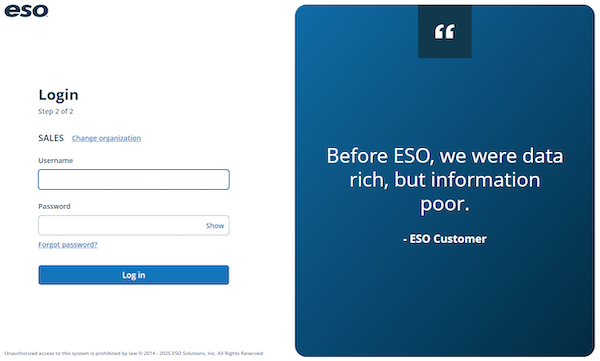
Fire Incidents | ESO NERIS Beta Program
NERIS Fire Incidents Beta Program
In early March, we launched our closed beta program, which allows a select group of agencies to access, train, and experience the brand new NERIS-compliant Fire Incidents. In turn, the agencies in the beta program are providing valuable feedback to help us refine and improve the application further. The beta program includes features such as progressive disclosure, rich text editing for narratives, and GIS integration for address fields. We have encouraged the agencies involved to include both administrators and field responders in the testing process to gather diverse feedback and ensure the application meets the needs of all users in their transition to NERIS.
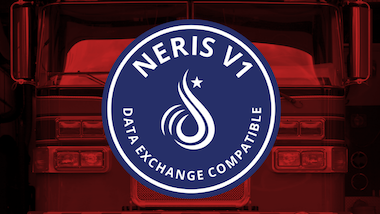
NERIS Data Exchange Compatibility Badge
We are proud to announce that ESO has officially received our NERIS Data Exchange Compatibility Badge, signifying that ESO Fire Incidents meets all new NERIS compliance requirements while maintaining ease of use, data accuracy, and intuitive reporting.
This badge signifies that you can feel confident in trusting ESO Fire Incidents to provide everything you need to smoothly transition to NERIS and stay ahead of the biggest change in fire reporting in the past 50 years. Moving forward, ESO will continuously enhance Fire Incidents while further integrating it with other applications within the ESO suite to ensure a comprehensive solution that continues to support the new NERIS standard while enhancing application capabilities and user experience.
EHR | iOS General Availability
EHR for iOS is now available to all, marking a major step forward for ESO. Designed to provide you with the proper tools to enhance patient care and quickly enter quality data, this latest release introduces Longitudinal Record (LR), Siri Integration, and Mobile to Mobile (M2M).
Built with the needs of first responders in mind, EHR for iOS offers a user-friendly interface, seamless integration with EHR Web and Windows Mobile, and robust security features to ensure patient data is protected.
Here are some key features to look out for:
- CAD & Cardiac Monitor Integration: The application supports integration with cardiac monitors and CAD systems, enhancing your ability to swiftly monitor and respond to patient needs. Supported cloud monitor integrations include Zoll Online (X Series), LIFENET System (LP 12, 15, and 35), and Philips IntelliSpace Corsium (Tempus ALS).
- Robust Security: EHR for iOS supports multi-factor authentication (MFA), Single Sign-On (SSO), and 6-digit Numeric PINs to support multiple crew members.
- Mobile Device Management: Agencies leveraging Mobile Device Management (MDM) to manage iOS devices in the field can now do so with a few additional steps.
- Medication Scanning: By using the device camera, patients’ medications can be added to their Medication list by scanning the prescription labels or lists of medications, saving your team precious time.
- Mobile to Mobile (M2M): Just like M2M is available with our Windows Mobile application, the EHR for iOS application supports the ability to send or receive data to and from a Windows Mobile or iOS device.
- Longitudinal Record (LR): Similarly to EHR for Web, EHR for iOS leverages our new Longitudinal Record feature to quickly look up and match patient information.
- Siri Integration: Activate Siri for hands-free entry of incident times and vital signs, as well as document flowchart treatments. It’s as simple as saying, “Hey Siri, capture pulse rate in EHR.”
Now available in the App Store, EHR for iOS has undergone rigorous testing and validation to ensure it meets the highest standards of performance and security, saving your team precious time in the field.
EHR | Stryker LIFEPAK 35 General Availability
Our latest integration with the Stryker LIFEPAK 35 monitor/defibrillator is now available for all and is designed to provide an enhanced user experience, boosted productivity, and access to the latest technologies. Thank you to the beta agencies who helped us ensure that this integration was ready for prime time.
Key Features of the LIFEPAK 35 Integration with EHR:
- Seamless Connectivity: Enjoy a user-friendly interface that makes it easy to connect Stryker LP 35 with ESO EHR. Experience improved performance that ensures smooth, uninterrupted data flow, allowing you to complete tasks more efficiently.
- Improved Patient Care: Focus on delivery of care with the ability to import data from the monitor to EHR, reduce documentation time, and improve your data’s accuracy.
- Dependability of Data: Use the strength of two trusted and dependable platforms in one high-quality solution.
Why Choose the LP 35 Integration?
Our integration with the Stryker LP 35 is designed to meet the needs of professionals who require reliable and efficient tools to manage their workflow. Whether you’re a responder in the field, an administrator, or a researcher, this integration offers you the functionality you need to be successful.
Patient Registry | Bulk Procedure Entry
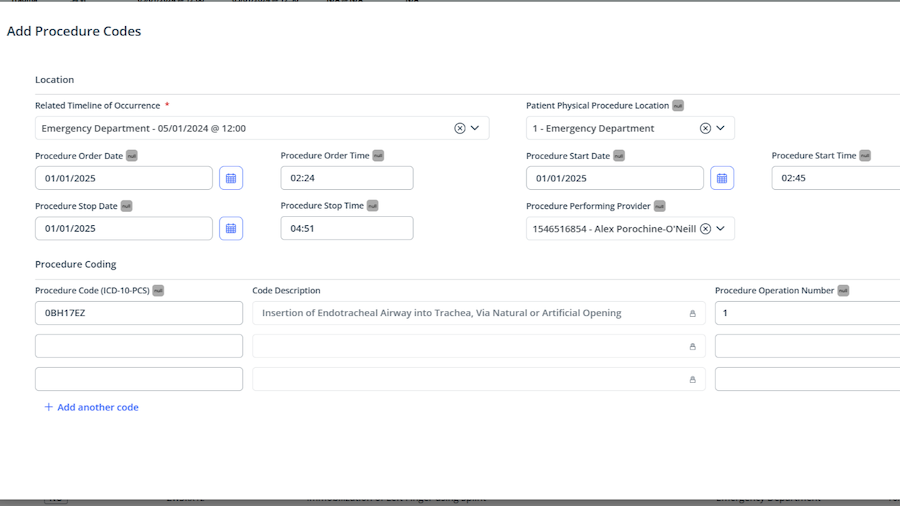
Through customer feedback and collaboration, ESO determined that enhancing bulk procedure entry was critical to the Patient Registry user experience. This update will significantly streamline daily operations by allowing your team to more efficiently manage and execute large volumes of procedures, reducing the administrative burden while improving workflow efficiency.
By automating routine tasks and enabling bulk processing, healthcare facilities can focus more on patient-centric activities, ensuring timely and accurate delivery of care. So far, we’ve already seen a 15% reduction in time on tasks and an 81% reduction in clicks to complete tasks. We hope that you find that this enhancement not only optimizes your resource utilization but also contributes to overall better patient outcomes and product satisfaction.
Patient Registry | FHIR Integration for Cerner

Building upon Patient Registry’s FHIR data integration with Epic, we extended the integration with Cerner to not only streamline your workflows but also enhance the overall efficiency and quality of your data. An ESO Admin page has also been launched that will allow facilities to self-configure their FHIR URLs and custom MRN identifiers.
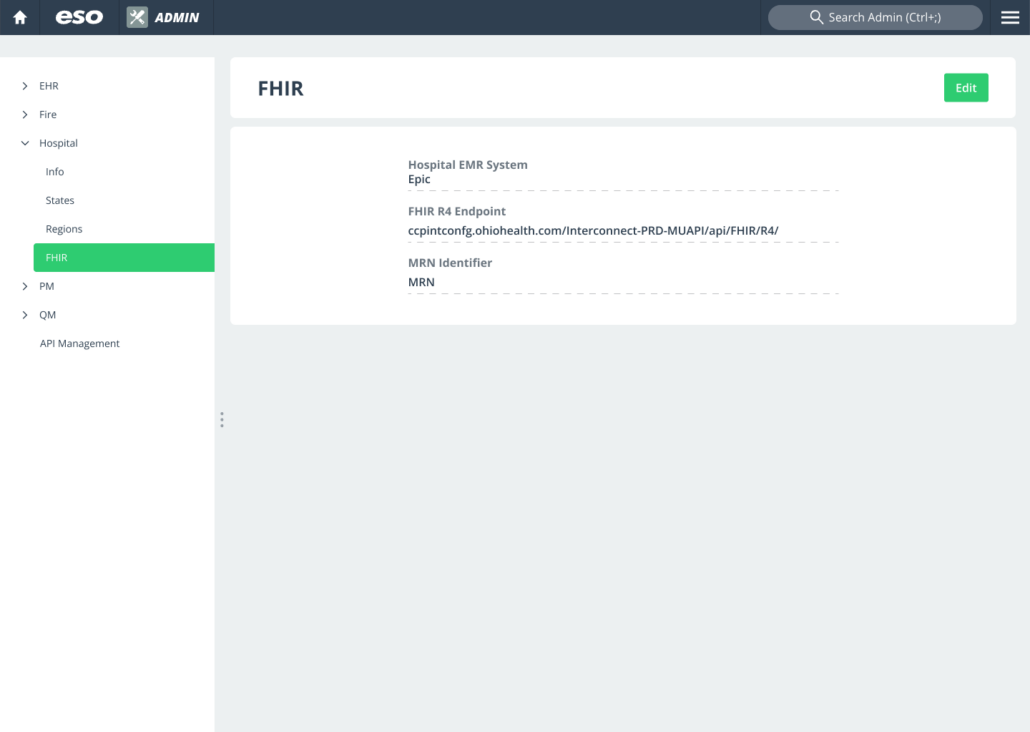
Stay tuned for more exciting updates on how the FHIR integrations will evolve and transform your Patent Registry experience!
Patient Registry | “No Bloods Given” Button
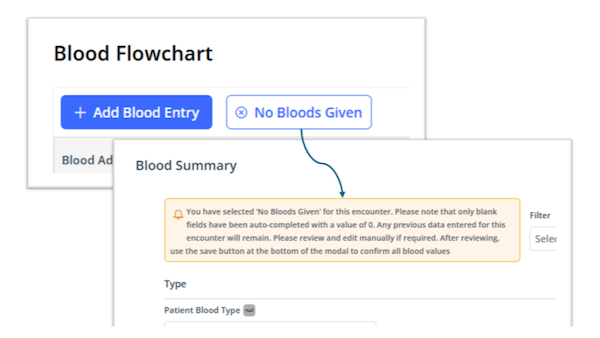
The new “No Blood” button feature on the “Blood” Flowchart section allows your team to directly interact with the “Blood Summary” modal without manually entering data field by field. This new update takes a process that originally took over 20 clicks down to just 2, saving your team vital time.
This feature was highly requested by Registry users who need to capture data for total blood and blood within 4 hours and has already been incredibly popular with users.
PM | Compensation (Payroll) Update
Development of the Compensation module is in full swing. This new module will cover payroll for volunteer, combination, and pay-per-call departments and can be used in conjunction with the Pay Rates feature. By enabling the Compensation module, organizations can integrate Fire Incidents into PM, along with creating and editing compensation definitions, adding and editing rules, managing employees, and exploring the pay period history page.
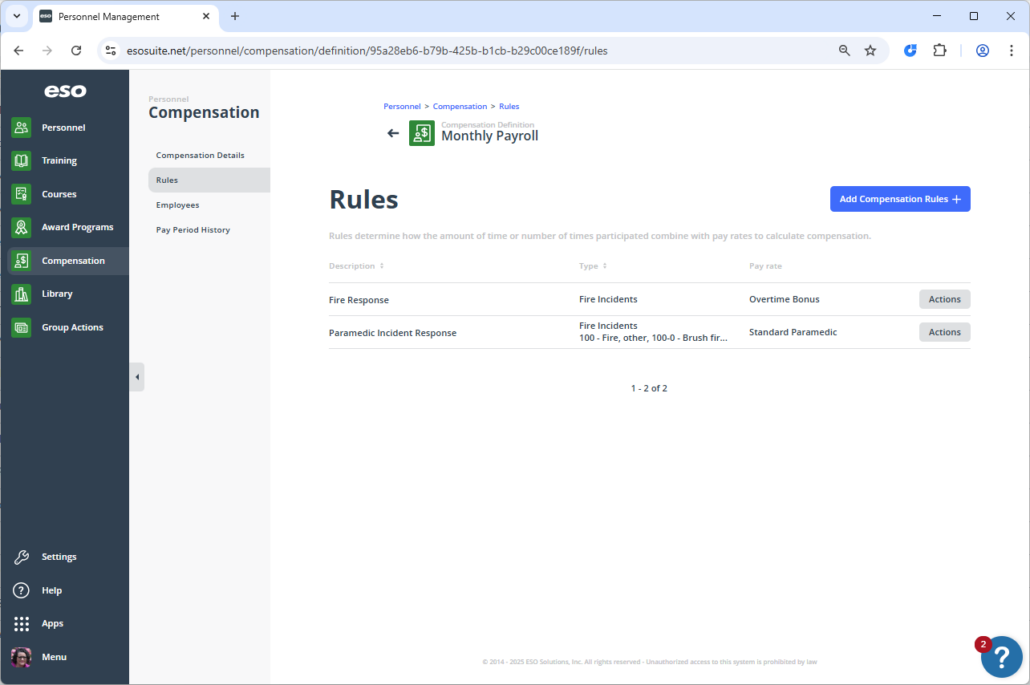
More exciting news: after our next release, your organization will be able to see live data on the pay period history page, view employees within the pay period, and dive into the calculation details, which means you can complete the entire cycle for rules based on Fire Incidents, right up to the export and finalization process. Stay tuned for more updates.
Assets | Preventative Maintenance Foundations
Asset Management has gone through several foundation updates to deliver a brand new end-to-end preventative maintenance functionality. Here are the updates that happened in Q1:
- Meter Readings in Equipment Profiles: Similar to what’s available in vehicle profiles, meter reading fields were added to the equipment profile to capture various readings.
- Maintenance Requests: When closing a maintenance request, you can now add current meter readings to the ticket, which will update the asset’s profile.
- Asset Spreadsheet Upload: Meter reading fields have been added to the upload spreadsheets to support importing current meter readings when onboarding to Assets.
These updates will allow you to enter meter readings in four different ways: by checklist submissions, maintenance requests, spreadsheet uploads, or direct edits to the asset profile.
The Maintenance Overview page has also been updated to support end-to-end preventive maintenance workflows. With the addition of Status, Complete Date, and Request Type columns, you can now quickly reference existing open requests and see whether a request was manually created or auto-generated.
Keep an eye out for the release of Maintenance Schedules, which will allow you to set recurring maintenance schedules based on odometer, engine hours, calendar, and more!
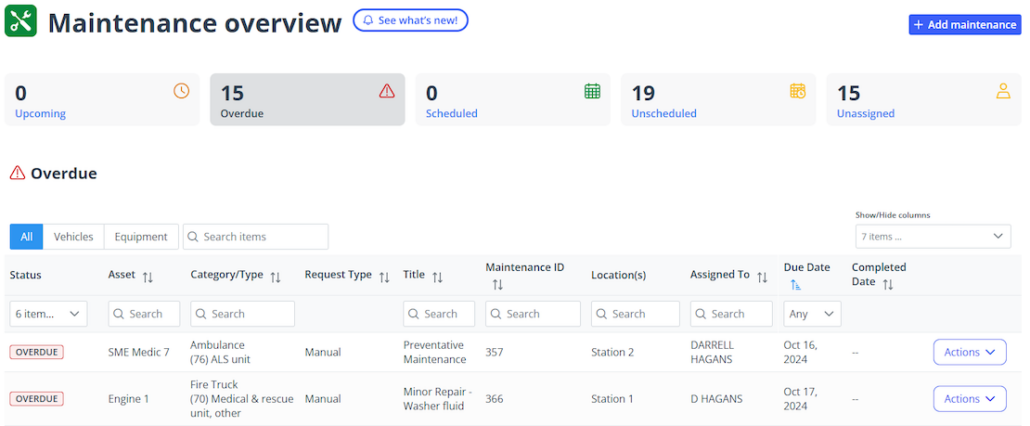
Data | Snowflake Direct Shares
ESO has released its latest data reporting and access capability – Snowflake Direct Shares. This new capability will allow you to seamlessly integrate ESO Suite reporting data into your own existing Snowflake account, as well as give you the capability to create customized queries and exports and combine ESO data with internal sources using your own data reporting tools. Eliminating the need for intermediary ETL tools, APIs, or other reporting platforms simplifies the data reporting ecosystem and reduces the management of additional credentials and access points.
Insights | Global Dashboards
A number of Global Dashboards were updated and released throughout Q1, but there are two groups of Dashboards we are particularly excited about:
EHR | WEMSIS Demographic Information Reporting Dashboards
A series of seven dashboards, the WEMIS Demographic Information Reporting Dashboards, are aimed at supporting WA customers who are required to report annual demographic data to WEMSIS. More information on the measures and submission can be found here.
State Repo NEMSIS 3.5 | California Core Test Measures
Five Global dashboard templates were released to support customers in CA regions and agencies by more accurately reflecting the specifications for the 5 CA core test measures for 2024 data (AIR-1, AIR-2, AIR-3, PED-4, & TRA-3). You can get more information here.
Cross-Product/ESO Suite | In-App Enhancements
In Q1, our UX and Personnel Management team launched our Pilot Ideas Portal in Personnel Management to make it even easier for our community to share feedback and gain insights into current product roadmap ideas. This portal is designed to enhance the collaboration process and make it easier for our product team to understand and solve our customers’ pain points. The pilot was a huge success with high adoption and engagement along with positive feedback. Last quarter alone, ESO received 2198 enhancement suggestions from our community, which is an increase of 33.4% from Q4!
Thank you for your continued hard work and dedication in helping us create tools to better support your team. We will continue to email you updates when viable ideas progress into the discovery, design, and development stages.
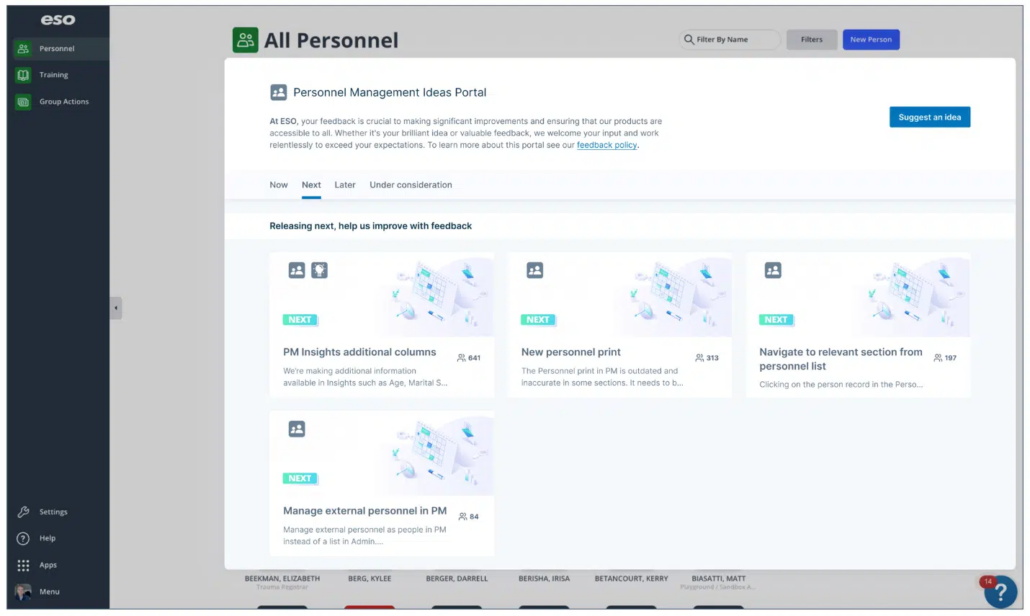
Stay turned for further rollout in the ESO Suite!
What to expect next
Here are a few more exciting enhancements currently in the works. Please stay tuned for release notes, but here’s a sneak preview of a few updates and enhancements we have planned:
EMS
- AI Generated Narrative for non-transport dispositions
- Additional availability in Windows mobile
- Our new iOS application
- Optional use of either SOAP or DCHARTE format
- NEMSIS critical patch for gender to maintain compliance with NEMSIS and presidential executive order
- New EHR Partner API
- Agency custom forms for beta
Fire
- NERIS
- GIS/Mapping for Properties Grid
- Inspections print and email updates
- Update to Hydrants for bulk actions
Shared Apps
- Preventative maintenance schedules
- General availability of compensation
Hospital
- Patient Registry has some exciting new features planned for Q2 (and beyond), including:
-
- An encounter dashboard for real-time reporting and operational workflow management.
-
- Patient summary export for generating templated reports for offline consumption.
-
- Integration with ACS to facilitate real-time encounter submissions.
State
- In Q2, we embark on a journey to transform the way State customers manage their providers, agencies, vehicles, and education with a new regulatory application. Leveraging the power of AI and development tools, we are poised to accelerate delivery, ensuring that our solutions not only meet but exceed your expectations.
Cross-Product / ESO Suite
- Dashboard will be mobile responsive
- The first release of our new Query Builder
- An Ideas Portal launch in all product resource centers
About Product Management at ESO
The ESO Product Management team creates the Product Roadmap, informing the products, features, and functionality we will build next. Through daily collaboration with support, sales, customer success, industry experts, and most importantly, customers like you, our team works hard to create the best apps possible for advancing our mission of improving community health and safety through the power of data.
Over the past year, we’ve invested in world-class tools that allow us to capture customer product feedback at scale and, in turn, make more informed roadmap decisions. These tools enable us to quickly test ideas in order to deliver features that are most valuable to you. We value your input and hope you continue to engage with us through our continuously expanding in-app capabilities.
The post (Q1/2025) ESO Updates: Quarterly Product Enhancements appeared first on ESO.
]]>The post Close the Gaps: Smarter EMS Information for Hospitals appeared first on ESO.
]]>Critical connections during emergencies
ESO Health Data Exchange (HDE) is the critical connection between the field and the hospital, giving emergency department (ED) clinicians near real-time access to prehospital care information during time-sensitive emergencies.
Just as your hospital evaluates and improves over time, ESO evolves its solutions to meet your changing needs. Read on to find the latest ESO HDE enhancements that provide hospitals with actionable insights into EMS activity and collaboration.
What’s new: Enterprise Master Patient Index (EMPI)
Benefit: Automated patient match rates of over 90% in under two minutes
Accurately matching patients with their prearrival care information is critical to patient safety, community health, and hospital business success. Poor patient-matching capabilities are both inefficient and costly. Repeated medical care because of duplicate records costs over $1,700 per ED visit, while denied claims from patient misidentification cost the average hospital $2.5 million.
ESO HDE now includes automated matching of hospital records to EMS encounters, thanks to Enterprise Master Patient Index (EMPI). This technology:
- Eliminates the need for paper runsheets
- Eliminates the need for wristband scans
- Greatly reduces time spent on manual searches
- Reduces care wait times while reconciling missing EMS records
Hundreds of hospitals now enjoy match rates of over 90%, which automatically occur in less than 120 seconds.
What’s new: EMPI matching for all responding units
Benefit: Shared patient outcomes and improved billing
In addition to patient identification, ESO HDE EMPI matching allows all units and agencies responding to an incident to qualify for an EMPI match. Without this enhancement, only the transporting EMS unit links to the patient, risking the loss of other agencies’ critical contributions because of unmatched records.
With the ESO HDE EMPI match:
- All responding agencies receive patient outcome information.
- All responding units can learn, update training if needed, and ultimately improve patient care.
- All services provided can be documented and billed, reducing missed revenue.
- All responding units automatically process through the ESO EMPI system, which is particularly crucial for high-utilization regions.
- Hospitals save time by no longer having to manually share outcomes with multiple responding agencies.
EMPI matching for responding agencies closes a critical gap in EMS data systems – ensuring every touchpoint during a response is captured, linked, and actionable.
What’s new: Integrated with ESO Insights
Benefit: Operational and clinical information in easy-to-understand reports
ESO HDE now includes ESO Insights, an integrated reporting platform that offers clear, easy-to-understand reports and visuals. Hospital leaders can embrace their data while using it to identify areas for performance improvement. ESO Insights is built with users in mind, offering point-and-click functions.
With all the data integrated into a single data platform, pre-built dashboards for both operational and clinical views are available. For example, operational dashboards include:
- EMS transport summary – View EMS transport data in different ways – including the top transporting agencies, reason for transport, and why patients are choosing your facility, etc.
- Ambulance Patient Offload Time (APOT) by facility and EMS agency – Previously accessible only through research, this data is now available at your fingertips.
Existing clinical dashboards include specific measures for stroke and STEMI. This offers a deep dive into understanding progress toward meeting standards
What’s new: ESO Suite enhancements
Benefit: Improved experience
You asked, and we answered! Three fresh enhancements to the ESO Suite include
- A federated single sign-on (SSO) – Enjoy a single password for all ESO applications. Plus, your designated IT administrators can create and disable users centrally and easily.
- Submit direct product feedback – When you share feedback in the suite, the product team triages it and keeps you informed about progress.
- Data Exporter tool – The ESO Data Exporter tool allows users to manage and export large amounts of data, simplifying data management. You can build, schedule, download, and email data exports directly.
Request a demo to see how ESO HDE can help your hospital enhance patient outcomes, streamline operations, and support performance initiatives throughout the emergency services journey.
The post Close the Gaps: Smarter EMS Information for Hospitals appeared first on ESO.
]]>The post Get Ready: NERIS National Rollout and Onboarding appeared first on ESO.
]]>If you missed it, don’t worry – we’ve got you covered. Here’s a recap of the major updates and what they mean for your department.
NFIRS Retirement and the Hybrid Reporting
Any new skill requires practice, whether it’s figuring out a new rescue tool, gaining confidence in ladder operations, or entering data in a new system. With NFIRS officially retiring on January 1, 2026, fire departments are preparing for onboarding and learning what NERIS will bring to their daily operations.
The webinar mentioned that fire departments will be able to transition to NERIS in 2025 based on their local needs and readiness. It’s important that you work with ESO, or your RMS vendor, to establish timelines. The goal of this reporting year is to ensure that departments can onboard in a way that minimizes disruption.
What does this mean for ESO customers?
For ESO customers, as your RMS vendor, we can work with you to access the NFIRS system for historical data once you complete the update.
What’s New? NERIS Features and System Improvements
The webinar highlighted several key changes in NERIS, designed to provide more accurate data, better risk analysis, and improved operational insights.
NERIS ID
Say goodbye to your old FDID. A major change is the transition from FDID to a unique, alphanumeric NERIS ID. Unlike FDIDs, which were only unique within a state, NERIS IDs are geospatially based and unique across the country. It is composed of your NERIS entity type, state and county FIPS codes, and random trailing characters. Each fire department will require their own NERIS ID to report for that agency.
This new identifier helps standardize reporting and ensures that data can be analyzed consistently across local, regional, and national levels. However, departments can still use their FDID locally while transitioning to the new system.
Multiple Incident Types
NERIS introduces multi-incident type reporting, allowing departments to log up to three incident types per call instead of being limited to just one.
For example, a single response might include:
- A vehicle fire
- A hazardous materials spill
- An entrapment requiring technical rescue
Being able to report multiple incident types gives a clearer picture of what firefighters encounter on scene and provides more detailed data for leadership and policymakers. Departments will need to work on policies to help drive their department to how they want to list incident types.
Improved Mutual Aid Tracking
Mutual aid data will be more precise, capturing not only whether aid was given or received but also the specific role that outside units played. The system distinguishes between:
- Aid given in support of another department
- Aid given in lieu of the primary department responding
- Aid provided under contract or acting as another agency
This structured approach helps departments track true call volume in their jurisdictions and better understand their mutual aid relationships.
Expanded Tactical Reporting
From suppression techniques to ventilation efforts, the new system captures detailed tactical data for smarter decision-making.
Fire departments can now document:
- Ventilation tactics (e.g., vertical, horizontal, hydraulic)
- Water application times
- Primary search status and completion times
- Rescues and victim outcomes
This level of detail wasn’t possible in NFIRS and will give departments better insight into the effectiveness of their actions on scene.
Geospatial Incident Mapping
NERIS integrates GIS data to provide real-time incident mapping and a clearer view of response patterns.
Departments will be able to analyze:
- Designated response areas
- Call density and geographic trends
- Mutual aid coverage and gaps
This data can support station placement decisions, resource allocation, and community risk reduction efforts.
Real-Time Data Quality Checks
To improve reporting accuracy, NERIS includes near real-time data validation at the point of entry for minimal rules. This helps reduce errors, missing data, and inconsistent reporting by flagging issues before a report is submitted.
Fire departments will no longer need to rely on manual reviews or wait weeks to identify reporting errors – the system provides immediate feedback to ensure high-quality data from the start.
The system will not capture responders and other related information. For these items, refer to your RMS vendor.
A Phased Approach to Rollout
Onboarding is happening in phases to ensure departments have the support they need. The transition plan includes:
- State Fire Marshal coordination to assist with training and outreach
- Early onboarding for small and large metro departments
- Regional onboarding based on FEMA regions, allowing departments within the same area to transition together
Collaboration with RMS vendors to ensure smooth data exchange for departments using third-party reporting systems.
Next Steps for Fire Departments
Here’s how your fire department can start preparing:
- Confirm Your Onboarding Timeline: Reach out to your state fire marshal or RMS vendor for your schedule.
- Initiate Training: Beginning in May 2025, FEMA regions will begin formally leading the onboarding process. Work with your vendor to understand the training process and when it will be available.
- Review Workflows: Analyze your current reporting processes and adjust them to align with NERIS standards.
- Stay Informed: Keep an eye on upcoming training resources, webinars, and updates to ensure you’re fully prepared. For more information on how to prepare, visit the official NERIS website.
How ESO is Supporting Your Transition
For more than a year, ESO has worked closely with FSRI to ensure we’re prepared to help you migrate to NERIS. From onboarding to data collection for reporting, our team is ready to support your transition. We’re ensuring that:
- Your NERIS account is set up with minimal disruption
- You receive hands-on, practical training
- Your transition to NERIS reporting is smooth and timely
Do you have questions about NERIS or do you need guidance on how ESO can help with your transition to the new system?
Visit our NERIS FAQs to learn more
The post Get Ready: NERIS National Rollout and Onboarding appeared first on ESO.
]]>The post The Clock Is Ticking on Trauma Center Time to Transfer appeared first on ESO.
]]>Delays from communication breakdowns, logistical issues, or procedural bottlenecks can make the difference between life and death. Specifically, traumatic brain injury, complex orthopedic injuries, and hemodynamic instability issues like hemorrhage all require rapid, specialized surgical intervention at higher-level trauma centers.
Key Findings: How Fast Are Trauma Patients Moving?
In this first exploration of time to transfer data, ESO considered time to transfer for emergency department patients, time to transfer for inpatient patients, and if trauma center level mattered. Data from the ESO Data Collaborative, which includes nearly 1 million anonymized patient records, show:
Emergency Department Transfers
- The median time to transfer was 78 minutes (Range: 63–84 minutes)
- Time to transfer varied by trauma center level but not significantly
Inpatient Transfers
- The median time to transfer was 141 minutes, nearly 2.5 hours (Range: 132–152 minutes)
- There was no clear trend between trauma center levels and inpatient transfer time
These findings challenge the assumption that higher trauma center levels always transfer patients more quickly. They also show that the proverbial ‘golden hour’ is rarely met, especially with inpatient transfers. There is room for improvement.
A Successful Reduction in Time to Transfer
The Oregon Health and Science University conducted a three-year quality improvement project on patient transfers. Measurable improvements include:
- Decreased the number of transfers that arrived with incomplete (or missing) medical records from more than 17% to just over 1%
- Decreased arrival-to-procedure time for patients being transferred for a procedure from 51 hours to 35 hours
- Decreased unnecessary transfers from 15% to 3%
- Increased case mix index by one-third, corresponding to about a 60% jump in reimbursement
How Can Trauma Centers Reduce Transfer Delays?
Trauma leaders, including the American College of Surgeons (ACS), emphasize the importance of rapid – and accurate – injury identification, established transfer protocols, and seamless communication between referring and receiving facilities.
Best practices for improving time to transfer include:
- Quickly identify trauma patients requiring transfer – ideally within 30 minutes of arrival
- Establish clear criteria for transfer, prioritizing patients needing specialized surgical care
- Create predefined agreements with higher-level trauma centers to streamline transfers
- Facilitate direct physician-to-physician communication for quicker acceptance
- Appoint a dedicated transfer coordinator to reduce logistical delays
- Focus on stabilization without unnecessary imaging or procedures that slow down the process
- Set and track a decision to transfer time as part of your trauma performance improvement program
- Regularly review transfer times with staff and provide feedback on identified delays
- Ensure compliance with state and regional trauma guidelines, some of which mandate specific transfer timeframes
The Bottom Line: Faster is Better
The data is clear: time to transfer can be improved, and hospital systems and trauma centers that optimize transfer times can improve patient survival and recovery.
Want to see how your facility compares to national benchmarks?
Download the full 2024 ESO Trauma Index to learn how your trauma center could improve patient outcomes and community health.
The post The Clock Is Ticking on Trauma Center Time to Transfer appeared first on ESO.
]]>The post (Q4/2024) ESO Updates: Quarterly Product Enhancements appeared first on ESO.
]]>Content Applicability by Product
| Building Blocks | EMS | Fire | Hospital | State |
| EMS | Shock Index | x | |||
| EHR | iOS Beta Release | x | |||
| EHR | Stryker LP35 Beta | x | |||
| EHR | MIH/Community Paramedicine Run Type | x | |||
| EHR | FLACC Pain Scale | x | |||
| EHR | GenAI Narrative Web Beta Release | x | |||
| Logis Dispatch | Voice Platform | x | |||
| Logis Dispatch | AVL Subscription API | x | |||
| Logis Billing | Automation and Integrations | x | |||
| Fire Incidents | NERIS Update | x | |||
| Hydrants | External API | x | |||
| Permits | External API | x | |||
| HDE | EMPI Matches | x | x | ||
| PM | Pay Rates | x | x | ||
| PM | New Classes Insights Dashboards | x | x | ||
| Activities | Edit Operational Tasks | x | x | ||
| Checklists | New Meter Reading Fields | x | x | ||
| Assets | Maintenance & Asset Profile Updates | x | x | ||
| Scheduling | Comp Time Enhancements | x | x | ||
| ODL | New PM and Assets Courses | x | x | ||
| Patient Registry | Onboarding Guide | x | |||
| Insights | Dashboards | x | x | x | |
| Insights | Data Synthesis, Validation and Accuracy tools (internal) | x | x | x | x |
| Cross-Product / ESO Suite | In-App Enhancement Feedback | x | x | x | x |
EHR | Shock Index
As part of our 2024 initiative to make Critical Care documentation more robust in ESO EHR, we’ve added Shock Index to Vitals in both Blood Pressure and Pulse Tiles. You can now automatically calculate Shock Index based off of the values you enter for Pulse and Systolic Blood Pressure.
EHR | iOS Beta Release
We’re excited to announce an early adopter preview release of our much-anticipated ESO EHR iOS application! This release will allow you to complete and sync all record fields to the web for validation and lock, while a second release happening later this month will let you do so in-app prior to syncing.
Stay tuned. We’re making the jump to general availability (GA) and adding new features such as CAD and Cardiac Monitor integrations, Longitudinal Record (LR), and Mobile-to-Mobile functionality.
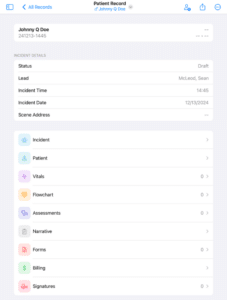
EHR | Stryker LP35 Beta
In Q4, we started beta testing the LIFEPAK 35, a brand-new ESO EHR cardiac monitor integration that receives transmissions through Stryker’s LIFENET API. The ability to import data from the monitor to ESO EHR reduces documentation time while improving the accuracy of your data, allowing you to better focus on the delivery of care. This new integration is now available to all ESO EHR users.
As technology modernizes in the field, ESO EHR will continue to advance its integrations to better support your needs, including the upcoming capability of importing 15-lead ECG waveform images.
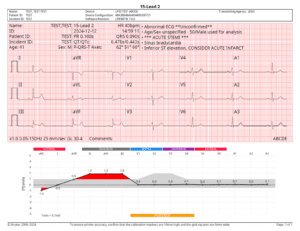
EHR | MIH / Community Paramedicine Run Type
Mobile Integrated Health (MIH)/Community Paramedicine has been added to ESO EHR to better support the unique workflow requirements of agencies that document MIH/CP visits. This run type and its required fields will streamline state submissions by removing many of the configurable validation requirements while giving you the tools necessary to manage your MIH/Community Paramedicine program’s unique documentation and reporting needs.
EHR | FLACC Pain Scale
The FLACC Pain Scale was part of our Critical Care initiative in 2024 and will be available in the Pain section within Vitals in ESO EHR. You can use it to directly document and upload FLACC Pain Scores and final score data for non-verbal patients into ESO Insights for easier reporting.
EHR | GenAI Narrative Web Beta Release
Currently in beta, the new GenAI Narrative Web feature for ESO EHR allows you to request an auto-generated Narrative on a PCR, streamlining data entry while improving focus on care. The first phase of our Auto-Generated Narrative uses the DCHARTE format, which allows you to request AI-generated narratives for Transport records with a “transport by this EMS unit” disposition.
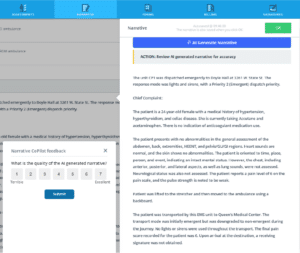
Our beta period will extend through the beginning of February. So far, customer feedback has been promising, and we will continue to collect and incorporate feedback throughout this period. This feature will be available to all customers on ESO EHR before Wave 2025.
Logis Dispatch | Voice Platform
A complete rewrite of the Logis Voice platform has been finalized and is now live with the first customer! The rewrite features a complete architectural makeover, client-side experience, and full ESO Chat functionality. Support for various phone systems will also be included in an upcoming phase.
Logis Dispatch | AVL Subscription API
The Logis Dispatch IDS API now includes the ability to subscribe to Automatic Vehicle Location (AVL) feeds. This enables you to perform live updates through webhooks in any system integrated into Logis Dispatch.
Logis Billing | Automation and Integrations
The ESO team was hard at work adding more automation and logic to the Billing solution, including:
- A new Payor Matrix feature that acts as a payor decision tree will further reduce the headache of incorrect payor denials. New integrations were added to enable bi-directional interactions with WayStar for insurance verification and discovery and Artiva for third-party patient invoice management. You can also now streamline frequent tasks by assigning hotkeys to your ten most-used functions.
- New configurations allow you to assign and report on workers’ claims for the Office of Worker’s Compensation (OWCP), assign provider numbers (Taxonomy) to service types to help reduce backend denials related to the services provided, and automate narrative generation and emergency statement form assignments based on payor rules and regulations through newly added narrative templates.
- Lastly, you’ll find updated logic that helps you identify and accept exceptions presented on manual 835 flat file imports, enhanced task views that assist with queue management and follow-up project preparation, updated contractual adjustments related to bundles and denials, and an automatic printing of ePCRs with paper CMS 1500 (HCFA) forms.
Fire Incidents | NERIS Update
Since late 2023, ESO has been actively working with FEMA and their contractor, UL (FSRI), to help you prepare for the transition to the National Emergency Response Information System (NERIS). In Q4 2024, FEMA delivered the final v.1 of the Phase 1 schema and a draft of the validation rules for incident reporting, which allowed us to validate some assumptions in our planning and adjust for future expansions of the rules. Our development team has been hard at work implementing our solution for NERIS with the goal of having a basic NERIS-compliant version of Fire Incidents ready for beta testing by the end of Q1 2025.
This basic version will not include auto-import configuration and integrations with CAD and EHR will not be added until upcoming releases in 2025. For more information, visit our FAQs About NERIS.
Hydrants | External API
Your Fire Data API subscription now includes a new external, bidirectional Hydrants API! This API provides direct, real-time access to hydrant data and allows for third-party integrations that make it easier to share your ESRI account with your water department and display shared hydrant and hydrant task data.
Hydrant records, including location, status, inspection and maintenance history, task scheduling, etc., can now be updated using the available API endpoints. To learn how to use the Hydrants API, head to the ESO API Developer portal.
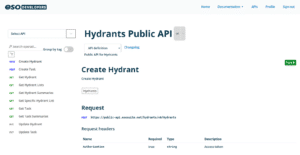
Permits | External API
A new external, bi-directional Permits API is now included in your Fire Data API Subscription. This API provides direct, real-time access to permit data, including type, status, fee, applicant, etc., which you can then update through available API endpoints. Head to the ESO API Developer portal to learn how to use your Permits API.
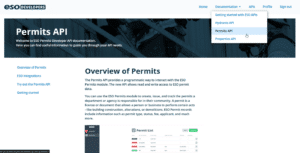
Public APIs allow us to incorporate the third-party services that improve your current ESO offerings and, in turn, improve your day-to-day workflows.
HDE | EMPI Matches
We have enhanced HDE EMPI matching to ensure that all units responding to an incident now qualify for an EMPI match rather than just a singular EMS record, which is what was previously eligible. This update guarantees that each of your responding units will be processed through our EMPI system, which is particularly crucial in regions with high first responder EHR utilization, such as Napa Valley and Monterey County in California and Providence Healthcare in Washington.
PM | Pay Rates
You can now track individual pay rate history on both PM Basic and purchased PM by heading to team members’ personnel records located in the Pay Rate section of the new Work Performance tab. You can also manage the complete list of hourly and flat rate pay rates by heading to PM > Settings. To enable this functionality, visit PM > Settings > Enable Add-Ons.
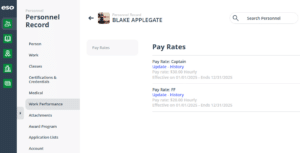
Pay Rates are available for any customer and are a prerequisite for the upcoming Compensation module. This new module will allow payroll calculations for volunteer and combination departments, as well as departments who have a pay-per-call model where personnel are paid by response.
PM | New Classes Insights Dashboards
Two new dashboards are available in Insights for PM! “Training Sessions and Duration by Personnel” is a global dashboard for customers who do not use credit hours and points for training classes and would prefer to calculate and record time based on session length.
The second dashboard, “PM – Classes – Quality Control,” will allow you to identify sessions with missing information (such as credits, instructors, or attendees) through a new quick selector bar graph and summary tables.
Activities | Edit Operational Tasks
This long-awaited Activities improvement will allow users with the appropriate security permissions to edit the fields of any completed operational task, including status. An audit trail located in the record will capture all changes made.
Checklists | New Meter Reading Fields
Based on your feedback, two additional meter reading fields have been added to Checklists: Aerial Hours and Generator Hours. These new options are now included in the editing process and, if enabled, will be available to your crew during checklist submissions.
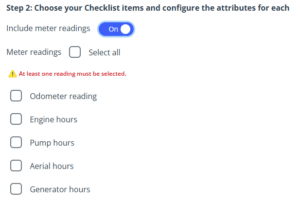
Assets | Maintenance & Asset Profile Updates
Several Asset updates were made in Q4, setting the stage for new Preventive Maintenance features coming in early 2025. Vehicle and equipment profile pages will now feature meter reading fields that can either be manually updated or automatically updated through Checklist submissions. We’ve also improved data storage to better support your Preventive Maintenance reminders and overall reporting experience.
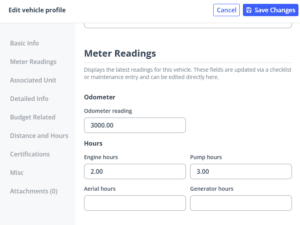
Meter reading fields have also been added to the Maintenance Request, along with view-only Created By and Created Date/Time fields, and the ability to set a vehicle back as in-service after the request is completed.
Scheduling | Comp Time Enhancements
Based on your feedback, administrators can now disable Schedule Conflicts for the Comp Time and Accrued Comp Time item types. This will allow schedulers to reflect the comp time used or accrued by employees while having a standard paid shift on the schedule.
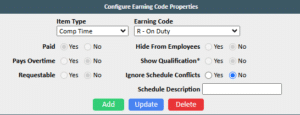
ODL – New PM and Assets Courses
Keep an eye out for two new On-Demand Learning (ODL) courses. “Personnel Management – Basic Setup and Use” is a refresh to the PM Basic course and is broken down into 14 short video modules designed to help you quickly find any information you need while making content more accessible. “Assets – Location Management” gets admin users up to speed on new Location Management features while also teaching them how to create, manage, archive, and organize locations and sublocations in Assets.
Insights | Dashboards
Our designers have been very busy this quarter building 48 new dashboards across the entire ESO Suite! Here’s a quick breakdown by product:
| Related Application | Number of New Dashboards |
| Patient Registry | 38 |
| Fire Incidents | 5 |
| Trauma Repository | 3 |
| EHR | 2 |
Cross-Product / ESO Suite | In-App Enhancements
In Q4, ESO received 1,646 enhancement suggestions from our community, and we have triaged and replied to 80.9% of those suggestions. We will continue to email you updates when viable ideas progress into the discovery, design, and development stages.
Our team worked on the next evolution of improving feedback throughout our software design and development process to ensure we are building exactly what your teams need. Our new Ideas Portal will be under tabs and mirror our Roadmap’s design and development stages:
- Now = Newly released features and updates
- Next = Works in progress with a delivery timeline
- Later = Ideas that are committed to the roadmap, but the timeline remains unknown
- Under Consideration = Ideas being actively investigated for feasibility
Look out for our pilot launch in Personnel Management early in Q1.
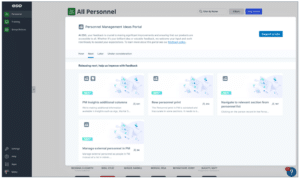
What to expect in Q1/25?
We have a few more exciting improvements in the works for Q1 2025. Please stay tuned for release notes and the next product blog, but here’s a sneak preview of upcoming updates and enhancements:
EMS
- EHR iOS GA
- Physio LP35 Integration GA
- Longitudinal Records for iOS and Windows Mobile
- EHR Web AI Generative Narrative – 1st Release
Fire
- GIS/Mapping (Properties Grid)
- Hydrants Bulk Actions
Shared Apps
- Scheduling – Shift Swap Refresh
- Assets – Preventive Maintenance Foundations
- PM – Compensation (Payroll for Vol/Combo) Phase 1
Hospital
- Compliance Matrix Tooling enhancements
- Cerner FHIR Integration
Cross-Product / ESO Suite
- A brand-new login screen and features
- Launching in early Q1, the Resource Center for Personnel Management will feature an ‘Ideas Portal’ pilot that will share ideas currently in various stages of design and development. To access it, click on the red notification in the Personnel Management Resource Center, which you can locate by clicking on the blue question mark in the bottom right-hand corner.
- If the ‘Ideas Portal’ pilot is a successful means of gaining more valuable feedback, we plan to launch a portal for each of our Resource Centers by the end of Q1. Please check it out and give us feedback on the value of the ideas presented.
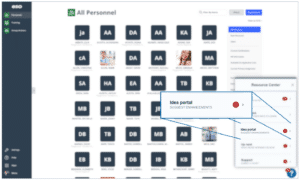
About Product Management at ESO
The ESO Product Management is responsible for creating the Product Roadmap, which outlines what products, features, and functionalities we will build next. Through daily collaboration with support, sales, customer success, industry experts, and, most importantly, customers like you, our team works hard to create the best apps possible to advance our mission of improving community health and safety through the power of data.
Over the past year, we’ve invested in world-class tools that allow us to capture customer product feedback at scale and, in turn, make more informed roadmap decisions. These tools enable us to quickly test ideas to deliver the most valuable features to you. We value your input and hope you continue to engage with us through our continuously expanding in-app capabilities
Want to look at the progress made on the ESO Product Roadmap in 2024? Check out the three previous ESO Updates Quarterly Product Enhancements blog posts below.
The post (Q4/2024) ESO Updates: Quarterly Product Enhancements appeared first on ESO.
]]>